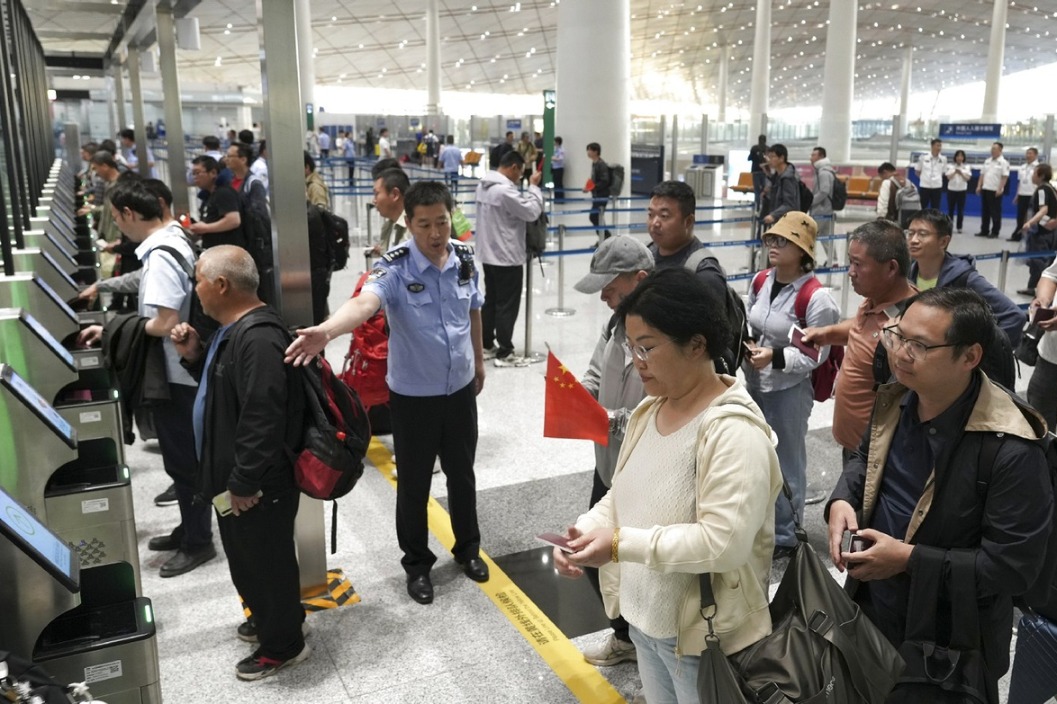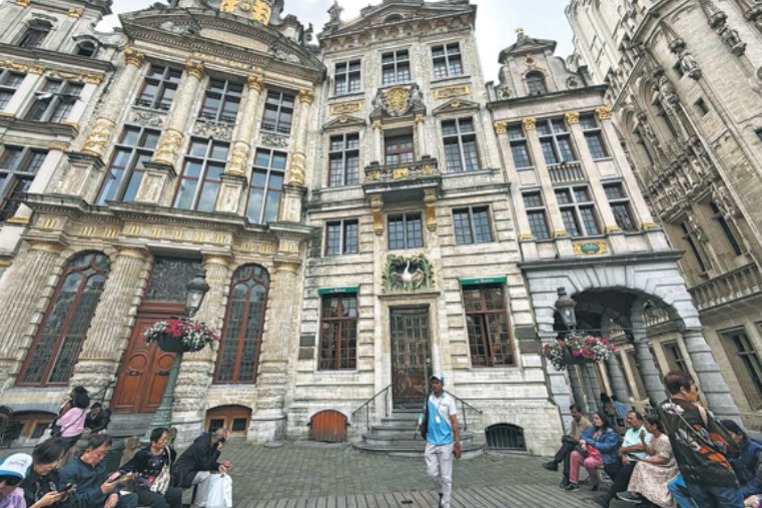TRACK TO THE FUTURE
How Beijing 2022's new high-speed rail link takes us on a journey through China's Olympic past

The high-speed rail line connecting 2022 Winter Olympic co-host cities Beijing and Zhangjiakou officially began operation on Dec 30 last year, marking another important step in the build-up to the Games.
However, more than just transporting spectators, the line also journeys back in time through history, linking major moments in the development of modern China and its Olympic odyssey.
Pioneers and provenance
In 1908, Zhang Boling, an educationalist and forerunner in China's engagement with the Olympic movement, published an article in the Tianjin Youth magazine, posing three questions: When can China send an athlete to participate in the Olympic Games? When can China send a team to participate in the Olympic Games? When can China host an Olympic Games?
In the same year, Zhan Tianyou, known as the "Father of China's railways", completed the construction of a rail line connecting Beijing and Kalgan (now known as Zhangjiakou), with a winding track negotiating the steep gradient in the mountainous area near the Great Wall.
The train would move its locomotive from the front to the back to change direction at Qinglongqiao Station, where Yang Cunxin and his father worked for a combined total of 68 years.
A 19-year-old Yang became station master after his father retired in 1981, but, by his own admission, it wasn't exactly his dream job.
"Simple, repetitive and boring, that's what working at a railway station is like," recalled the 58-year-old candidly.
Yang had reason enough to complain. He sometimes worked 24-hour shifts and was responsible for over 20 trains. Only once in his 38 years at the station was he able to get time off to celebrate Chinese New Year with his family.
Later in life, though, Yang became fascinated by the rich history of the line, designed and built exclusively by Chinese labor. After frequently being asked about the railway's origins by travelers, he began to read articles and books on the station and visited Zhan Tianyou's family.
"I feel extremely honored and proud to devote all my life to this historical station," Yang told Xinhua.
Olympic odyssey
Before Yang's years of duty and dedication, China's Olympic journey had already begun. At the 1932 Los Angeles Games, sprinter Liu Changchun became the nation's first Olympian by competing in the men's 100m and 200m.
Four years later, a 69-strong Chinese team competed in five events at the Berlin Games, answering the second of Zhang's three questions.
His last was answered when giant golden footprints traversed along the axis from Tian'anmen Square to the Bird's Nest stadium to mark the opening of the 2008 Beijing Games as China's century-old Olympic dream was finally realized.
On Aug 1, a week before the opening ceremony, the Beijing-Tianjin intercity railway began operation, ushering in China's new high-speed rail era.
There were big changes, too, at Qinglongqiao Station. With faster alternatives available, fewer and fewer trains would stop there. Eventually, the station ceased to cater to passenger trains, instead providing a technical stopover for the suburban line S2, which opened two days before the opening ceremony.
This helped trigger the station's rebirth, bringing it to the attention of the government's industrial heritage investigation team, which restored it to its original early-20th-century state, thanks to experts from the Capital Museum and Yang's knowledge.
The station became a tiny museum and Yang assumed a new role-tour guide.
"In the past, passengers of different genders weren't able to stay together in one waiting room. This one is for male passengers, and the one on the opposite side is for females," Yang said in tour-guide mode.
"This is an advertisement of the American company that manufactured the locomotive used to climbed the gradient on the zigzag section."
Busy with both restoration and his regular duties, Yang admitted that he did not have much time to watch the 2008 Olympics.
And he was not the only one to miss the "extraordinary" Games, as it was hailed by then-International Olympic Committee president Jacques Rogge. Zhang Shijie was also working overtime at China Railway Engineering Consulting Group.
"Work occupied our minds. Sometimes we hoped meals could go directly into our stomachs without having to eat," Zhang Shijie said.
"My only memory of the Games was that China won a lot of gold medals, even edging the United States to top the table."
Born in Zhangjiakou, Zhang Shijie had to travel through Beijing en route to his grandmother's hometown in Shandong province, and the zigzag track at Qinglongqiao was a regular feature of his childhood.
"I remembered the train was really slow. It left at around 7:15 am and would not arrive in Beijing until almost 1 pm," recalled Zhang Shijie, who never thought that one day he would visit Qinglongqiao Station numerous times to design a high-speed rail link that cut the travel time between Beijing and his hometown to under an hour.
Beyond the dream
"Beijing!" The city's name was called for a historic second time to host an Olympic Games on July 31,2015.
After a successful 2008 edition, the capital will become the first city in the world to stage both summer and winter Games when it resumes hosting duties in 2022.
The historic moment was witnessed by Zhang Shijie, who became head subgrade engineer of the Beijing-Zhangjiakou high-speed railway. He celebrated, arms aloft, with his team members.
"Our railway will serve as an important part of the Olympic infrastructure!" he proudly proclaimed.
At the same time, the successful bid brought greater responsibilities and a tighter schedule.
"You never know the sense of responsibility of working on a big project until you are on one," Zhang Shijie said.
"At that time, as long as we were awake, we were on the construction sites. We totally gave up our leisure time and hobbies."
The 38-year-old made sure he knew every one of the project's 100 construction sites inside-out. He even walked with his team from Donghuayuan county to Zhangjiakou, inspecting about 90 kilometers on foot. In the process, he became well acquainted with Qinglongqiao Station.
"Our railway goes below the old Beijing-Zhangjiakou line. The ceiling of the tunnel comes as close as four meters to the old track. We gave careful consideration to every detail to minimize any effects to the historic site," he explained.
Sitting on the test train before the railway officially went into operation on Dec 30 last year, Zhang Shijie and his team members were overwhelmed by emotion as memories of their work came flooding back.
"This railway is like our child. We were so worried it was not well-developed or not as good as others," he said."It is a line I will never forget in my life."
The 174-kilometer line added to China's world-leading 35,000 kilometers of high-speed rail in operation by the end of 2019. It boasts a potential speed of 350 km/h, 10 times that of its predecessor.
"We've made huge leaps forward in high-speed railway technology, but where did it all start? Right here! The first railway entirely designed and built by us Chinese!" Yang said.
"Qinglongqiao Station has borne witness to two historic encounters. Over a century ago, the railway went through the Great Wall, with Western industrial civilization meeting traditional Chinese culture.
"Now the high-speed rail intersects with the old track, demonstrating that China has developed from being a learner to a leader."


Today's Top News
- Diabetes affects 233 million Chinese, study says
- Chinese economy shows resilience, prioritizes tech, talent investment
- US' lawbreaking attacks further step toward abyss: Editorial flash
- UN chief Guterres says US strike on Iran a dangerous escalation
- US attacks three Iranian nuclear sites
- Trump says US has attacked 3 Iranian nuclear sites






























